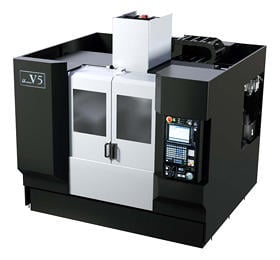Press Information
Mitsubishi Heavy Industries Machine Tool Launches "µV5" Micro Milling Machine
-- Newest Addition to the µV (micro V) Series Allows for Machining of Large Workpieces with Micrometer-Level Precision --
-- Newest Addition to the µV (micro V) Series Allows for Machining of Large Workpieces with Micrometer-Level Precision --
Tokyo, January 26, 2017 - Mitsubishi Heavy Industries Machine Tool, Co., Ltd., a Group company of Mitsubishi Heavy Industries, Ltd. (MHI), has developed the "µV5" (micro V5) micro milling machine, the latest in its µV (micro V) series. The µV5 has a bigger working surface table and wider process stroke than the current µV1, allowing for high-efficiency machining with micrometer-level (1/1,000 mm) precision for large products or those that require fine milling using small diameter tools, such as molds for car optical components. The µV5 meets demand for a wide range of applications such as precision automotive parts, large-scale molds for display casings and other products, separators* (the main component of fuel cells), and shaping blades for rotating machines.

The primary spindle used in the µV5 is a high-speed, high-performance wide range spindle, which also ensures high precision with little thermal displacement. Further, Mitsubishi Heavy Industries Machine Tool's proprietary Optical Image-type Tool Measurement System can accurately measure the position of the rotating tool end using a high resolution CCD (charge coupled device) camera, allowing for tracked precision machining even for cuts with micrometer-level accuracy. The working surface of the table is 1,050×550 mm, and can accommodate large workpieces of up to 800 kg.
The µV series lineup includes the three-axis µV1, and the five-axis µV1-5X machine with a tabletop inclined spindle and rotating spindle, expanding the range of applications to include cutting of non-ferrous materials, and producing various types of small tools. The lineup is highly regarded for low downtime and minimal deterioration in precision over time, as well as the proprietary Optical Image-type Tool Measurement System. The introduction of the µV5 allows for precision machining of larger products.
Mitsubishi Heavy Industries Machine Tool announced the µV5 at a private showing held at its Ritto District Main Plant on February 2 (Thursday) and 3 (Friday). The company used demonstrations of die and mold machining to present a wide variety of precision machining solutions, and going forward will further expand the range of applications with the addition of spindle variations.
| Travels | X-, Y-, and Z-axes | 900×550×450 mm |
|---|---|---|
| Distance from spindle end to table top | 150 to 600 mm | |
| Table | Working surface | 1,050×550 mm |
| Max. workpiece size (W×D×H) | 1,050×700×450 mm (Shape limited) | |
| Max. loading capacity | 800 kg | |
| Distance from floor level to top | 900 mm | |
| Tabel top shape | Five T-slots of 18 mm | |
| Spindle | Rotational speed | 300 to 30,000 RPM |
| Motor output/torque | 15kW/19N·m | |
| Taper size | HSK-E50 | |
| Feedrate | Rapid traverse rate | 15,000 mm/min |
| Cutting feedrate | 1 to 15,000 mm/min | |
| Automatic Tool Changer (ATC) | Tool storage capacity | 18 tools |
| Max. tool diameter | φ50 mm | |
| Max. tool length | 200 mm | |
| Machine Size & Weight | Height | 2,790 mm |
| Width×Depth | 2,760×2,600 mm | |
| Weight | 10,500 kg |
* Separators are plates of metal or carbon with electricity flow properties, comprising the cells generate power in polymer electrolyte fuel cells. They are positioned between membrane electrode assemblies (MEAs) with a catalyst applied to the solid polymer electrolyte membrane. The surface is etched with fine grooves that allow hydrogen and air to pass.
Product pageAbout MHI Group
Mitsubishi Heavy Industries (MHI) Group is one of the world’s leading industrial groups, spanning energy, smart infrastructure, industrial machinery, aerospace and defense. MHI Group combines cutting-edge technology with deep experience to deliver innovative, integrated solutions that help to realize a carbon neutral world, improve the quality of life and ensure a safer world. For more information, please visit www.mhi.com or follow our insights and stories on spectra.mhi.com.




